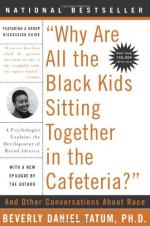
|
| Name: _________________________ | Period: ___________________ |
This test consists of 5 short answer questions, 10 short essay questions, and 1 (of 3) essay topics.
Short Answer Questions
1. The first African slaves were brought to Jamestown, Virginia in what year?
2. Tatum believes that self-segregation and declining academic achievement are the result of ___________.
3. Beverly Daniel Tatum received her B.A. in psychology from which institution?
4. What term means to state or assert positively; maintain as true?
5. When was 'Why Are All the Black Kids Sitting Together in the Cafeteria?': A Psychologist Explains the Development of Racial Identity published?
Short Essay Questions
1. What is Tatum's argument against those who suggest keeping silent regarding race with children in Part II, Understanding Blackness in a White Context, Chapter 3, The Early Years?
2. What does the author assert is needed in order to overcome racial prejudices in identity in Part II, Understanding Blackness in a White Context, Chapter 4, Identity Development in Adolescence?
3. What experiment does the author describe enacting on young students in Part I, A Definition of Terms, Chapter 2, The Complexity of Identity? What results does she find?
4. How does the author address the subject of slavery when dealing with children in Part II, Understanding Blackness in a White Context, Chapter 3, The Early Years?
5. How does the author describe the reasons black children begin sitting together at lunch in Part II, Understanding Blackness in a White Context, Chapter 4, Identity Development in Adolescence?
6. What does the author write in Part II, Understanding Blackness in a White Context, Chapter 3, The Early Years that she begins adult seminars with asking?
7. What co-evolving processes construct personal identity according to the author in Part I, A Definition of Terms, Chapter 2, The Complexity of Identity?
8. How does Tatum describe racial identity in relationship to religion in Part II, Understanding Blackness in a White Context, Chapter 5, Racial Identity in Adulthood?
9. How does Tatum describe differences between men and women in racial identity in Part II, Understanding Blackness in a White Context, Chapter 4, Identity Development in Adolescence?
10. How do white and black children differ in their responses to the author's experiment in Part I, A Definition of Terms, Chapter 2, The Complexity of Identity? How do boys and girls respond differently?
Essay Topics
Write an essay for ONE of the following topics:
Essay Topic 1
Discuss Tatum's assertion that Whites, in resisting racism, often want to simply retreat into their individuality. What does the author mean by this phrase?
Essay Topic 2
Define and discuss the terms "people of color" and reverse racism. How does the author choose to use these terms and why?
Essay Topic 3
Discuss the differences and similarities between the dominant and subordinate groups described in the author's experimentation in Part I, A Definition of Terms, Chapter 2, The Complexity of Identity. How might the responses change at different ages?
|
This section contains 949 words (approx. 4 pages at 300 words per page) |

|




